When it comes to drafting players for your best ball fantasy leagues, the choices you make in the early rounds can significantly impact your team’s performance. To ensure success, it’s crucial to select the right players. Additionally, considering the concept of opportunity cost and constructing your team optimally is of the utmost importance. Opportunity cost in this context is the value forgone by selecting a player early in the draft, as it reduces the potential to acquire other high-value players that other drafters may select later.
This article will explore the concept of opportunity cost in relation to early round selections. Also, it will provide valuable insights to improve your fantasy football strategy. Note: ADPs are drawn from Underdog Fantasy and Best Ball Points Added per game (BBPA pg) are drawn from PlayerProfiler.com.
– 🐶 Sign up for Underdog Fantasy➔ Click Here! and use Code UNDERWORLD for a $100 instant deposit match
Positional Depth, Scarcity, and Point Disparity
Quarterbacks
In the first five rounds of fantasy drafts, seven quarterbacks are typically selected. Notably, six of these seven quarterbacks finished in the top-6 of best ball points added per game in 2022. The remaining QB, Justin Herbert (QB20 in bbpa pg in 2022), reached an elite ceiling as the QB3 overall in best ball points added per game in 2021. However, missing out on an elite quarterback in drafts can be difficult to recover from. The difference in best ball points added per game between the QB1 overall Jalen Hurts (8.15 bbpa pg) and QB6 overall Lamar Jackson (4.85 bbpa pg) was equivalent to the difference between Jackson and approximately QB22 Tom Brady (1.68 bbpa pg) in 2022. It’s evident that there is a clear top-3 tier with Hurts, Allen, and Mahomes. This is followed by a tier-2 with Jackson, Burrow, and Fields.
Running Back
Within the first five rounds of BBM4 drafts, 17 running backs are typically selected. This accounts for 28-percent of draft picks. However, it’s worth noting that more than 43-percent of the top-60 best ball points added per game scorers in 2022 were running backs. This percentage was also 40% in 2021. These figures indicate that there is a higher chance of finding best ball contributors from the running back position outside of the first five rounds, contrary to what the ADP (average draft position) suggests. Identifying running backs beyond the fifth round who can outperform their ADP provides a significant edge.
Wide Receiver
Wide receivers are often drafted early on the Underdog platform compared to other platforms. However, there is a notable disparity between the performance of elite wide receivers and those in subsequent tiers. The gap between WR1 Cooper Kupp (14.32 bbpa pg) and WR7 A.J. Brown (9.48) is similar to the difference between Brown and WR27 Chris Olave (4.69). In Best Ball Mania 4, 28 of the top-60 picks (47-percent) are wide receivers. In 2022, 48-percent of the top-60 best ball points added per game scorers were WRs. The percentage was 47-percent in 2021. It is important to prioritize selecting at least three wide receivers within the first five rounds to align with the market trend.
Tight Ends
Currently, only three tight ends are being drafted in the first five rounds of Underdog drafts: Travis Kelce, Mark Andrews, and T.J. Hockenson. George Kittle is a close contender but falls slightly outside this range. It’s worth noting that all top-4 tight ends have consistently produced more than 4.0 bbpa pg over the past two years. However, the TE4 position has ranked significantly lower, being the 68th and 52nd highest best ball points added per game scorer in the past two seasons.
The difference between TE1 Travis Kelce (8.71 bbpa pg) and TE2 George Kittle (5.43) is similar to the difference between Kittle and TE12 Juwan Johnson (2.19). Drafting Kelce provides a significant positional advantage.
Year-to-Year Comparison
To gain a better understanding of opportunity cost, it’s crucial to compare player performance from one year to the next. Past performance should be a strong indicator of future success. Let’s look at how each position fared when comparing 2021 to 2022.
Quarterbacks
When examining the year-to-year correlation of best ball points added per game, quarterbacks exhibit the least reliability. This might be attributed to quarterback touchdown variance and the smaller positional sample size, which includes both quarterbacks who played but underperformed and quarterbacks who significantly improved their play.
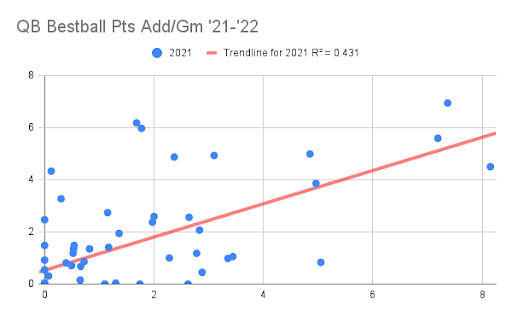
Running Backs
Compared to quarterbacks, running backs show stronger year-to-year correlation but still exhibit statistically significant or outlier changes. Factors such as post-apex age, injuries to elite players, and backup running backs seizing better opportunities can contribute to these changes.
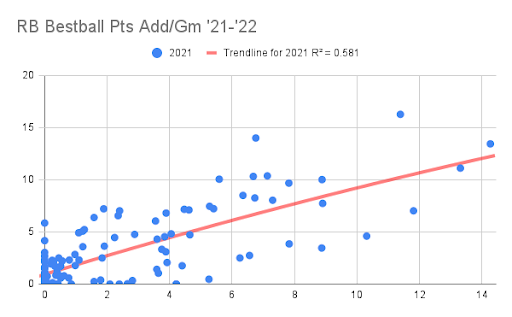
Wide Receivers
Wide receivers demonstrate the strongest correlation between best ball points added per game in consecutive years. This supports the notion that good receivers tend to remain consistent in their performance, while underperforming receivers also tend to continue struggling.
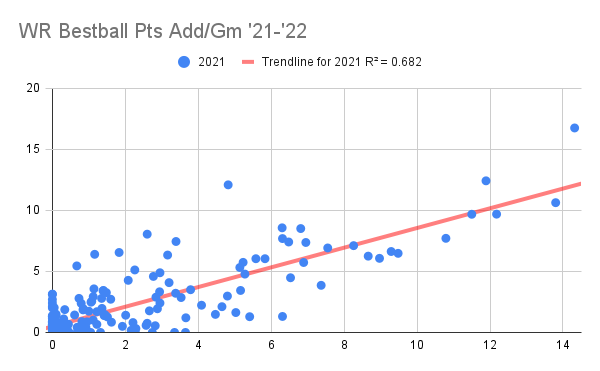 Tight Ends
Tight Ends
Tight ends display the most robust correlation of best ball points added per game from year to year. However, it’s important to note that only four tight ends have consistently produced 4.0 or more best ball points added per season over the past two years. Tight ends who fail to reach this threshold are unlikely to do so in subsequent seasons.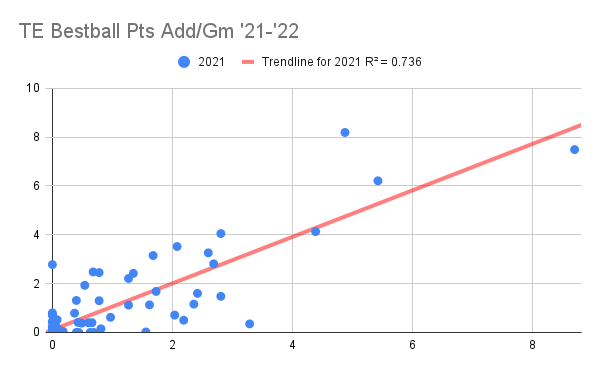
In general, the strongest confidence should be placed in drafting wide receivers and tight ends who have demonstrated consistent production in the past. On the other hand, previous production for quarterbacks or running backs may introduce higher-risk selections.
Early Rounds Comparison
Now, let’s focus on the Top-60 (Rounds 1-5) players drafted in Underdog’s ADP:
Quarterbacks
Quarterbacks drafted in the top five rounds display weak correlation between their best ball points added rates in 2021 and 2022. This is influenced by a small sample size of quarterbacks, as well as the significant variation in performances, such as Justin Herbert‘s underperformance and Justin Fields‘s rapid rise.
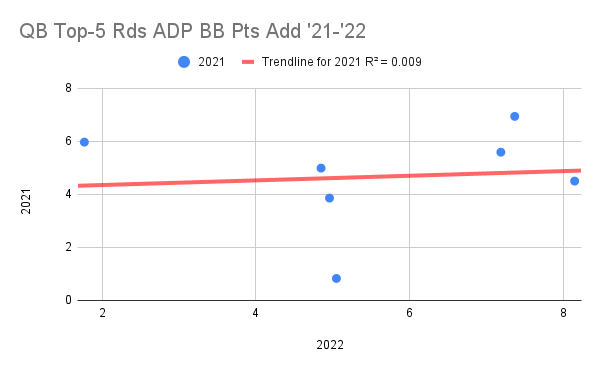
Running Backs
Top-60 overall ADP running backs exhibit a stronger correlation between their best ball points added rates from 2021 to 2022 compared to quarterbacks. However, the overall correlation remains relatively weak. Factors such as age, injuries, and increased opportunities for young running backs contribute to noticeable changes in performance.
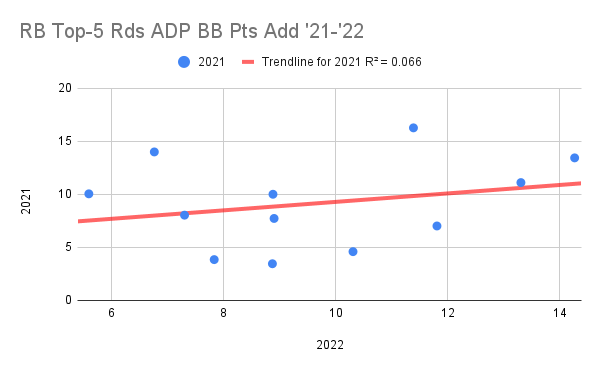
Wide Receivers
Among the top 60 ADP players, wide receivers showcase a strong correlation between their best ball points added rates in consecutive years. In fact, wide receivers demonstrate the strongest correlation compared to other positions. By removing outliers like Deebo Samuel, the correlation is even more pronounced. This reinforces the idea that wide receivers’ previous year’s production significantly influences their performance in the following year. Furthermore, the large sample size of wide receivers in the first five rounds boosts the reliability of the data.
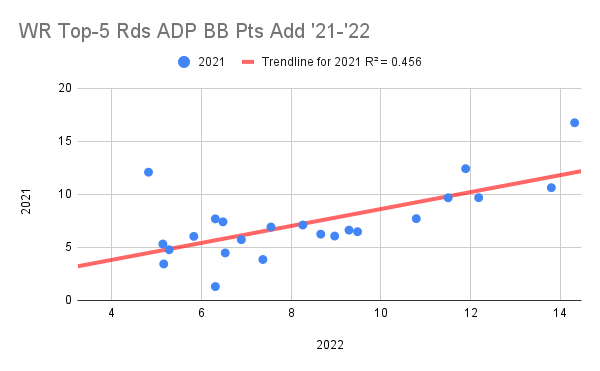
Tight Ends
Only three tight ends, Travis Kelce, Mark Andrews, and Hockenson, are typically drafted in the first five rounds. Including George Kittle does not significantly impact the data. However, with a small sample size and weak significance, it’s clear that Kelce has been the difference maker among tight ends.
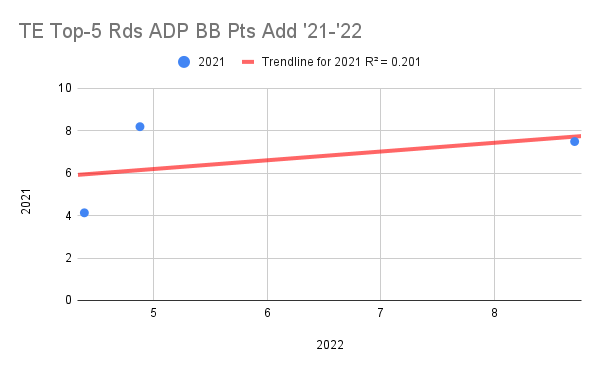
Understanding opportunity cost is essential for maximizing success in your best ball drafts. By analyzing positional depth, scarcity, point disparities, and year-to-year player performance, you can make informed decisions during the early rounds.
Prioritizing elite quarterbacks, recognizing undervalued running backs, generally securing three wide receivers within the first five rounds, and capitalizing on positional advantage offered by the top tight ends will strengthen your fantasy team.


